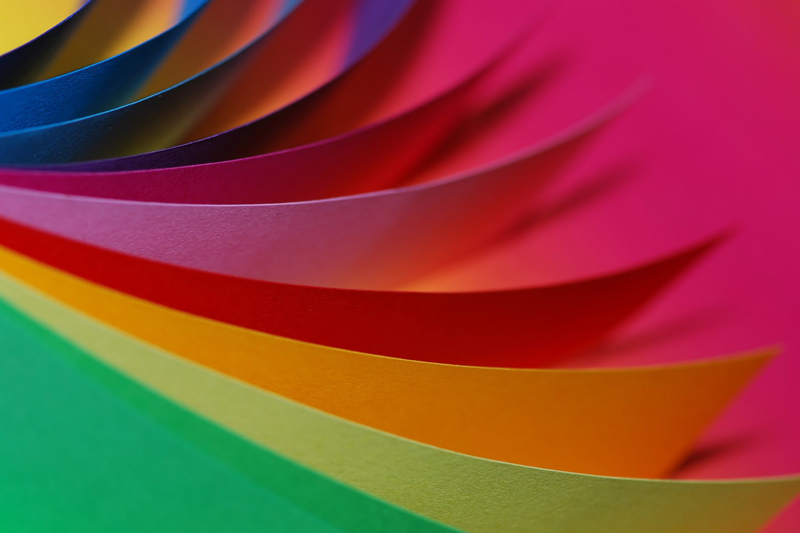Rolled Paper Beads - An Overview

Paper beads have been with us since Victorian times, when strips of wallpaper were rolled and strung to make curtains. Today, rolled paper beads are used in making jewelry and other beaded accessories. The tools and materials for rolled paper beads are so easy to source, and the techniques so easy to learn and master, that the craft has evolved from being a mere hobby to a highly viable livelihood for impoverished communities in countries such as Uganda and the Philippines.
Rolled paper beads are made from a variety of papers ranging from glossy magazines, wall calendars, and gift wrappers, to scrapbook paper, Japanese washi and other specialty papers. Some enthusiasts have also used unconventional materials like freezer paper or deli wrap.
The paper is cut into long strips, rolled, secured with glue, and finished with a sealant. The shape of the bead depends on how the paper is cut. Long, skinny isosceles triangles, for instance, result in bi-cone shaped beads, while rectangular strips result in tube beads. Patterns for cutting paper are readily available on the Internet; try searching for “paper beads templates”.
The tools you need for making rolled paper beads are readily available at home. These include a ruler, pencil, craft knife and cutting mat (or paper trimmer), and something to roll the paper. This can be a cocktail toothpick, a bamboo skewer, a quilling needle, or a bead roller made specifically for making paper beads. You can also use a slotted quilling tool if you’re making small beads, i.e., the base of which is not more than 3/8 of an inch. As bead rolling has its roots in quilling, the same principle applies: Roll the paper snugly and tightly with even tension.
A glue stick or PVA glue that dries clear works fine for paper beads, although for nonconventional materials like freezer paper, or certain types of metallic paper, you’d have to use a tackier kind of adhesive to ensure that the bead doesn’t unravel.
Finally, you would need a sealant to make the bead water resistant. Acrylic varnish, Diamond Glaze, gel medium, Mod Podge, or clear nail polish are OK. If you’re just starting out with bead making, use whatever sealant you have on hand; you can upgrade later if you find that you need a more professional finish. Just remember that while the finished beads will hold up to a certain degree of moisture, they’re not waterproof, so keep them out of the pool, shower, sink and rain!
In the next article we’ll look at some websites that serve as useful resources for making rolled paper beads.
Rolled paper beads are made from a variety of papers ranging from glossy magazines, wall calendars, and gift wrappers, to scrapbook paper, Japanese washi and other specialty papers. Some enthusiasts have also used unconventional materials like freezer paper or deli wrap.
The paper is cut into long strips, rolled, secured with glue, and finished with a sealant. The shape of the bead depends on how the paper is cut. Long, skinny isosceles triangles, for instance, result in bi-cone shaped beads, while rectangular strips result in tube beads. Patterns for cutting paper are readily available on the Internet; try searching for “paper beads templates”.
The tools you need for making rolled paper beads are readily available at home. These include a ruler, pencil, craft knife and cutting mat (or paper trimmer), and something to roll the paper. This can be a cocktail toothpick, a bamboo skewer, a quilling needle, or a bead roller made specifically for making paper beads. You can also use a slotted quilling tool if you’re making small beads, i.e., the base of which is not more than 3/8 of an inch. As bead rolling has its roots in quilling, the same principle applies: Roll the paper snugly and tightly with even tension.
A glue stick or PVA glue that dries clear works fine for paper beads, although for nonconventional materials like freezer paper, or certain types of metallic paper, you’d have to use a tackier kind of adhesive to ensure that the bead doesn’t unravel.
Finally, you would need a sealant to make the bead water resistant. Acrylic varnish, Diamond Glaze, gel medium, Mod Podge, or clear nail polish are OK. If you’re just starting out with bead making, use whatever sealant you have on hand; you can upgrade later if you find that you need a more professional finish. Just remember that while the finished beads will hold up to a certain degree of moisture, they’re not waterproof, so keep them out of the pool, shower, sink and rain!
In the next article we’ll look at some websites that serve as useful resources for making rolled paper beads.
You Should Also Read:
Websites on Paper Bead Making

Related Articles
Editor's Picks Articles
Top Ten Articles
Previous Features
Site Map
Content copyright © 2023 by Mia C. Goloy. All rights reserved.
This content was written by Mia C. Goloy. If you wish to use this content in any manner, you need written permission. Contact Mia C. Goloy for details.


